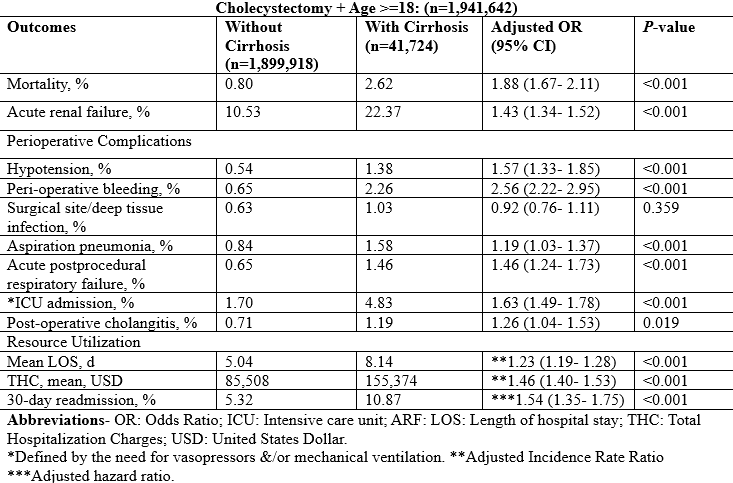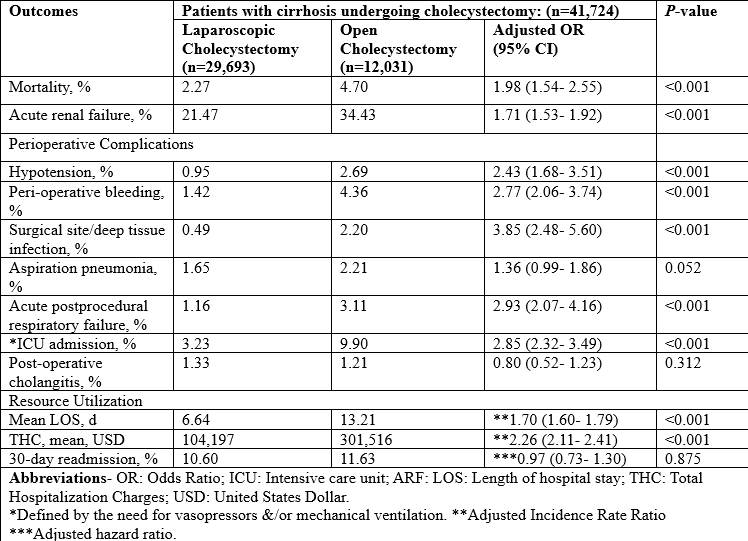Monday Poster Session
Category: Liver
P3680 - Outcomes and Trends in Cholecystectomy Among Patients with Cirrhosis: A National Retrospective Cohort Study
Monday, October 27, 2025
10:30 AM - 4:00 PM PDT
Location: Exhibit Hall

Ali Jaan, MD
Unity Hospital
Rochester, NY
Presenting Author(s)
Ali Jaan, MD1, Adeena Maryyum, 2, Alishba Shezal Ali, 3, Umer Farooq, MD4, Kamran Qureshi, MD5
1Unity Hospital, Rochester, NY; 2Ayub Medical College, Abbottabad, North-West Frontier, Pakistan; 3Rawalpindi Medical University, Rawalpindi, Punjab, Pakistan; 4Saint Louis University, Saint Louis, MO; 5Saint Louis University School of Medicine, Saint Louis, MO
Introduction: Cirrhosis is a known risk factor for adverse surgical outcomes, yet national data on cholecystectomy (CCY) in this population remain limited. We evaluated operative outcomes, readmissions and contemporary trends among cirrhotic patients undergoing CCY.
Methods: We conducted a retrospective cohort study using the Nationwide Readmissions Database (2016–2019). Adults undergoing inpatient CCY were identified using ICD-10 codes and stratified by the presence of cirrhosis and operative approach (laparoscopic vs. open). Multivariable regression models were used for outcome analysis.
Results: Among 1,941,642 hospitalizations for CCY, 41,724 (2.2%) patients had cirrhosis. Gallbladder-related disease (cholecystitis, cholangitis, or cholelithiasis) was the most common indication in both groups (80.4% in cirrhosis vs. 86.7% without). Cirrhotic patients had higher in-hospital mortality (2.62% vs. 0.80%; adjusted odds ratio (AOR) 1.88; P< 0.001), more complications, increased admission to the intensive care unit, longer length of stay, and higher hospitalization charges (P< 0.001). Thirty-day readmissions were more frequent in patients with cirrhosis (10.87% vs. 5.32%; adjusted hazard ratio 1.54, P< 0.001), most commonly due to cirrhosis-related decompensation. Use of laparoscopic CCY in cirrhotics increased from 64.4% in 2016 to 71.0% in 2019 (P=0.018). Among cirrhotics, open CCY was associated with significantly higher mortality and complications compared to laparoscopic CCY, though readmission rates were similar.
Discussion: Cirrhosis is independently associated with adverse outcomes following CCY. While laparoscopic CCY is increasingly adopted and offers favorable perioperative outcomes, cirrhosis remains one of the key drivers of morbidity and readmission. These findings emphasize the importance of individualized risk assessment, careful patient selection, and coordinated perioperative care to improve outcomes in this population.

Figure: Table 1: Outcomes of hospitalizations for cholecystectomy, stratified by the presence of cirrhosis.

Figure: Table 2: Outcomes of hospitalizations for cholecystectomy in patients with cirrhosis, stratified by the cholecystectomy approach.
Disclosures:
Ali Jaan indicated no relevant financial relationships.
Adeena Maryyum indicated no relevant financial relationships.
Alishba Shezal Ali indicated no relevant financial relationships.
Umer Farooq indicated no relevant financial relationships.
Kamran Qureshi indicated no relevant financial relationships.
Ali Jaan, MD1, Adeena Maryyum, 2, Alishba Shezal Ali, 3, Umer Farooq, MD4, Kamran Qureshi, MD5. P3680 - Outcomes and Trends in Cholecystectomy Among Patients with Cirrhosis: A National Retrospective Cohort Study, ACG 2025 Annual Scientific Meeting Abstracts. Phoenix, AZ: American College of Gastroenterology.
1Unity Hospital, Rochester, NY; 2Ayub Medical College, Abbottabad, North-West Frontier, Pakistan; 3Rawalpindi Medical University, Rawalpindi, Punjab, Pakistan; 4Saint Louis University, Saint Louis, MO; 5Saint Louis University School of Medicine, Saint Louis, MO
Introduction: Cirrhosis is a known risk factor for adverse surgical outcomes, yet national data on cholecystectomy (CCY) in this population remain limited. We evaluated operative outcomes, readmissions and contemporary trends among cirrhotic patients undergoing CCY.
Methods: We conducted a retrospective cohort study using the Nationwide Readmissions Database (2016–2019). Adults undergoing inpatient CCY were identified using ICD-10 codes and stratified by the presence of cirrhosis and operative approach (laparoscopic vs. open). Multivariable regression models were used for outcome analysis.
Results: Among 1,941,642 hospitalizations for CCY, 41,724 (2.2%) patients had cirrhosis. Gallbladder-related disease (cholecystitis, cholangitis, or cholelithiasis) was the most common indication in both groups (80.4% in cirrhosis vs. 86.7% without). Cirrhotic patients had higher in-hospital mortality (2.62% vs. 0.80%; adjusted odds ratio (AOR) 1.88; P< 0.001), more complications, increased admission to the intensive care unit, longer length of stay, and higher hospitalization charges (P< 0.001). Thirty-day readmissions were more frequent in patients with cirrhosis (10.87% vs. 5.32%; adjusted hazard ratio 1.54, P< 0.001), most commonly due to cirrhosis-related decompensation. Use of laparoscopic CCY in cirrhotics increased from 64.4% in 2016 to 71.0% in 2019 (P=0.018). Among cirrhotics, open CCY was associated with significantly higher mortality and complications compared to laparoscopic CCY, though readmission rates were similar.
Discussion: Cirrhosis is independently associated with adverse outcomes following CCY. While laparoscopic CCY is increasingly adopted and offers favorable perioperative outcomes, cirrhosis remains one of the key drivers of morbidity and readmission. These findings emphasize the importance of individualized risk assessment, careful patient selection, and coordinated perioperative care to improve outcomes in this population.

Figure: Table 1: Outcomes of hospitalizations for cholecystectomy, stratified by the presence of cirrhosis.

Figure: Table 2: Outcomes of hospitalizations for cholecystectomy in patients with cirrhosis, stratified by the cholecystectomy approach.
Disclosures:
Ali Jaan indicated no relevant financial relationships.
Adeena Maryyum indicated no relevant financial relationships.
Alishba Shezal Ali indicated no relevant financial relationships.
Umer Farooq indicated no relevant financial relationships.
Kamran Qureshi indicated no relevant financial relationships.
Ali Jaan, MD1, Adeena Maryyum, 2, Alishba Shezal Ali, 3, Umer Farooq, MD4, Kamran Qureshi, MD5. P3680 - Outcomes and Trends in Cholecystectomy Among Patients with Cirrhosis: A National Retrospective Cohort Study, ACG 2025 Annual Scientific Meeting Abstracts. Phoenix, AZ: American College of Gastroenterology.
